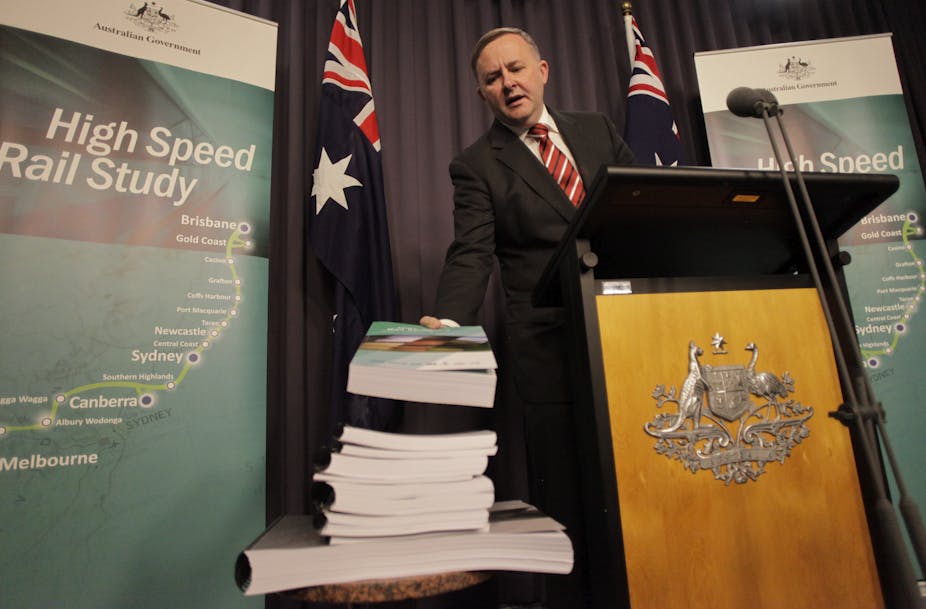Transport Minister Anthony Albanese today released the second phase report for Australia’s High Speed Rail Study. The AECOM report plots out a preferred route from Brisbane to Melbourne, predicts how many passengers will ride the system, and suggests the system would be marginally beneficial and economically feasible.
The costs are staggering. At around $114 billion it would dwarf any national infrastructure program yet undertaken – around three times the size of the National Broadband Network.
Even using a 4% discount rate (which would be considered “unusual” in most economic circles) the economic benefit/cost ratio is worryingly low at around 2.3 to 1 (that is, for every one dollar spent, it generates $2.30). And that’s after factoring strong population and economic growth through to the year 2065.
The patronage projections are also difficult to pull apart. There is a long history of inaccuracy in forecasting patronage in such projects due to two reasons. Bent Flyvberg, Professor of Planning at Oxford, calls “optimism bias and strategic misrepresentation”.
And we are hardly world-beaters in this country in estimating the value and viability of projects. The high speed rail projections are brought to you by the same firm responsible for the calamitous Lane Cove Tunnel, Sydney Cross City Tunnel and Brisbane Clem7 forecasts.
By my estimation if only half the business passengers on the Brisbane-Sydney and Sydney-Melbourne routes switched from air to rail, rather than the two-thirds estimated in the AECOM report, the high speed rail system would require massive subsidies to meet its operating costs.
Most people would baulk from committing at this point. The only review of the international experience with high speed rail, published by researchers at the University of Las Palmas in Spain in 2009, is sober reading. The average subsidy for the German, French, Spanish and Italian systems was calculated at over A$65,000 per seat, per year.
Indeed, it is claimed that only two routes in the world are currently profitable, in Lyon-Paris and Tokyo-Osaka. It is extremely doubtful that even the Sydney-Melbourne route could match that performance.
The reasons are many:
Australian cities are small by international standards (Greater Osaka’s population being ten times bigger than Brisbane’s)
our cities are less dense and have employment centres more dispersed than in Europe or Asia
the distances betweeen our major centres are both huge and sparsely populated (the Tokyo Osaka line passes ‘small’ cities like Nagoya, which is half the size of Sydney
there are few feeder rail lines from regional cities outside the corridor to support a high speed network.
Only when Brisbane, the Gold Coast, Sydney and Melbourne are of greater size, and the regional centres between them are larger, does high speed rail seem to warrant investment. Unless of course oil suddenly becomes scarce.
All that said, it seems prudent to plan and protect a corridor. It’s not overly expensive to work out a detailed alignment and preserve it from incompatible land development. This does little harm and ensures we can move forward if and when circumstances change and/or the time is right.
But should high speed rail be built right now? Let’s compare some options. The cost of getting from Brisbane and the Gold Coast to Newcastle (and no further) is projected to be around $21 billion. If we take that on face value (without knowing how much it would really cost to tunnel through mountains to the Gold Coast) what could that buy in terms of other rail investments?
The figure of $4 billion could give Brisbane a federal contribution to the much needed Cross River Rail project, which Tony Abbott ruled out funding in favour of freeways last week, consigning most Brisbane residents and Gold Coast commuters to what is already becoming Australia’s worst rail system.
And $1.5 billion could triple the size of the under-construction Gold Coast light rail. Another billion dollars would give the Sunshine Coast its first high-quality public transport infrastructure, which is becoming one of the most pressing needs in all of urban Australia (but there are no marginal seats up there). Half a billion dollars could give Coffs Harbour and Port Macquarie embryonic public transport systems. And you would still have $12 billion change to do the next set of necessary improvements in all those cities.
Similarly, a much smaller slice of the total high speed rail funds could give Sydney its metro system, Melbourne its rail tunnel, and give Perth, Canberra, and Adelaide the high quality light rail systems they are all planning for.
Alternatively, a major investment in freight rail to allow double-stacking of containers from Melbourne to Sydney and Brisbane, as works so well on the Melbourne-Adelaide-Perth route, would deliver undeniable long-term economic benefit to the nation and remove thousands of trucks from our roads.
So high speed rail might be a good investment, in future. It just might also be the worst of the possible rail projects to fund at this moment in time. Alternative investment strategies would more likely change people’s lives for the better and make our cities more efficient and productive.

